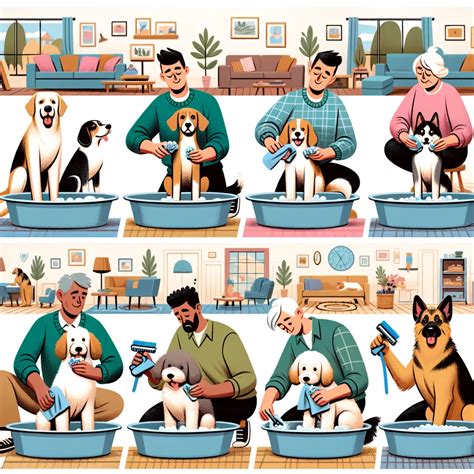
A golden retriever named Wrigley has social media users captivated after a video showcasing his clear preference for one parent over the other went viral. The canine’s dramatic seating choice, consistently opting to sit next to his “dad,” has sparked a lighthearted debate about pet favoritism and the bonds animals form with their human companions.
Golden Retriever’s Viral Seating Preference Sparks Debate About Pet Favoritism
A video of Wrigley, a golden retriever, exhibiting a marked preference for sitting next to one of his owners has ignited a flurry of online discussion regarding pet favoritism. The clip, originally posted on TikTok by Wrigley’s owners, shows the dog consistently choosing to sit beside his male owner, much to the amusement and mock dismay of his female owner. The video, which has garnered millions of views, highlights the often-unpredictable nature of animal companionship and the unique bonds that form between pets and their human families.
The now-viral video shows the couple sitting on a couch, with ample space for Wrigley to sit comfortably between them. However, the golden retriever unequivocally chooses to wedge himself next to his “dad,” often nudging and pushing to get as close as possible, even when his “mom” playfully tries to entice him to her side. This consistent behavior has led viewers to speculate about the reasons behind Wrigley’s preference, ranging from scent to personality to past interactions.
“It’s undeniable! Wrigley has made his choice,” one user commented, capturing the sentiment of many viewers who found the dog’s behavior both humorous and endearing. The video serves as a lighthearted reminder of the joys and quirks of pet ownership, and the complex emotional lives of animals.
While the video is presented in a humorous light, it also touches on a common experience for pet owners: the perception of being the “less favored” human. This can lead to feelings of amusement, curiosity, or even slight jealousy. However, experts emphasize that pet preferences are often based on a variety of factors and do not necessarily reflect a lack of affection for the other members of the household.
The Science Behind Pet Preferences
Understanding why pets develop preferences for certain individuals requires considering several factors, including scent, routine, personality, and past experiences.
-
Scent: Animals, particularly dogs, have a highly developed sense of smell. They can differentiate between individuals based on their unique scent profiles. Certain scents might be more appealing or comforting to a dog than others, leading them to gravitate towards individuals with those scents. For example, a dog might prefer the scent of someone who spends more time outdoors or engages in physical activity.
-
Routine and Association: Dogs are creatures of habit, and they often associate specific individuals with positive experiences, such as feeding, playing, or going for walks. If one person consistently provides these positive interactions, the dog is likely to develop a stronger bond with that individual. In Wrigley’s case, his “dad” might be the primary caregiver who feeds him, takes him for walks, or engages in his favorite activities, leading to a stronger association and preference.
-
Personality and Energy Levels: Pets are often drawn to individuals whose personalities and energy levels align with their own. A high-energy dog might prefer someone who is active and playful, while a more reserved dog might prefer someone who is calm and gentle. The dynamic between Wrigley and his owners might be such that his “dad’s” personality is more compatible with his own.
-
Past Experiences: Early experiences, particularly during puppyhood, can have a significant impact on a dog’s preferences. If a dog had a positive experience with a particular type of person or behavior during its formative years, it might be more likely to seek out similar interactions in the future. For instance, if Wrigley was primarily cared for by men during his early puppyhood, he might naturally gravitate towards his male owner.
Expert Perspectives on Pet-Human Bonds
Animal behaviorists and veterinarians offer insights into the complexities of pet-human relationships and the factors that contribute to pet preferences.
“It’s not necessarily a reflection of love; it’s more about association and what that person represents to the animal,” says Dr. Sarah Johnson, a certified animal behaviorist. “Dogs are incredibly perceptive, and they quickly learn who provides them with the most rewarding experiences.”
Dr. Johnson emphasizes that pet owners should avoid taking pet preferences personally. “It’s important to remember that every animal is an individual with its own unique personality and preferences. Just because a dog seems to prefer one person doesn’t mean it doesn’t love or appreciate the other members of the household.”
Another common misconception is that dogs only bond with the person who feeds them. While food is undoubtedly a powerful motivator, it’s not the only factor that determines a dog’s preferences. “Dogs also value companionship, play, and affection,” says Dr. Mark Thompson, a veterinarian specializing in animal behavior. “The person who spends the most time interacting with the dog, engaging in its favorite activities, and providing it with emotional support is likely to be the one it forms the strongest bond with.”
Addressing Feelings of Being the “Less Favored” Human
It’s natural for pet owners to feel a twinge of disappointment or even jealousy when they perceive that their pet prefers someone else. However, there are several strategies for strengthening the bond with your pet and becoming the “favorite” in their eyes.
-
Increase Positive Interactions: Spend more time engaging with your pet in activities they enjoy. This could include playing fetch, going for walks, grooming, or simply cuddling on the couch. The more positive interactions you have, the stronger your bond will become.
-
Become the Primary Caregiver: Take on more responsibility for your pet’s care, such as feeding, grooming, and walking. This will create a stronger association between you and the positive experiences your pet enjoys.
-
Use Positive Reinforcement: Train your pet using positive reinforcement techniques, such as rewarding them with treats or praise when they exhibit desired behaviors. This will not only improve their obedience but also strengthen your bond.
-
Respect Their Preferences: While it’s important to try to strengthen your bond with your pet, it’s also important to respect their individual preferences. Forcing your pet to interact with you when they clearly prefer to be with someone else can actually damage your relationship.
The Broader Impact of Viral Pet Videos
The popularity of videos like Wrigley’s highlights the powerful role that pets play in our lives and the emotional connections we form with them. These videos often resonate with viewers because they reflect relatable experiences and emotions. They also provide a source of lighthearted entertainment and a sense of community, as people share their own stories and experiences with their pets.
Furthermore, viral pet videos can raise awareness about important issues, such as animal welfare, responsible pet ownership, and the benefits of pet adoption. By showcasing the unique personalities and capabilities of animals, these videos can help to promote empathy and compassion towards them.
Wrigley’s Story as a Microcosm of Pet-Human Relationships
Wrigley’s seemingly simple preference for sitting next to his “dad” encapsulates the complexities of pet-human relationships. It demonstrates the power of association, the importance of positive interactions, and the unique bonds that form between animals and their human companions. While the video is presented in a lighthearted manner, it touches on deeper themes of love, loyalty, and the often-unpredictable nature of animal behavior.
Ultimately, Wrigley’s story serves as a reminder that pets enrich our lives in countless ways, providing us with companionship, affection, and a constant source of amusement. Whether they choose to sit next to us, play with us, or simply offer us their unwavering love and support, pets are an integral part of our families and deserve our care, respect, and appreciation.
FAQ: Wrigley’s Viral Video and Pet Preferences
-
Why does Wrigley consistently choose to sit next to his “dad” in the video?
Wrigley’s preference is likely due to a combination of factors, including scent, routine, personality, and past experiences. His “dad” might have a scent that Wrigley finds more appealing, or he might be the primary caregiver who feeds him, takes him for walks, or engages in his favorite activities. It’s also possible that Wrigley’s personality and energy levels are more compatible with his “dad’s.”
-
Does Wrigley’s preference mean he doesn’t love his “mom”?
No, Wrigley’s preference does not necessarily mean he doesn’t love his “mom.” Pet preferences are often based on a variety of factors and do not reflect a lack of affection for other members of the household. Wrigley likely has a different type of relationship with his “mom,” and he might show his love and affection in different ways.
-
What can pet owners do if they feel like their pet prefers someone else?
Pet owners can strengthen their bond with their pet by increasing positive interactions, such as playing, walking, or cuddling. They can also become the primary caregiver, taking on more responsibility for feeding, grooming, and training. It’s important to use positive reinforcement techniques and to respect the pet’s individual preferences.
-
Are pet preferences common?
Yes, pet preferences are common. Many pets form stronger bonds with certain individuals due to factors like scent, routine, personality, and past experiences. It’s important to remember that every animal is an individual with its own unique personality and preferences.
-
What is the main takeaway from Wrigley’s viral video?
The main takeaway is that pets enrich our lives in countless ways and that the bonds we form with them are complex and multifaceted. Wrigley’s video highlights the power of association, the importance of positive interactions, and the often-unpredictable nature of animal behavior. It also serves as a reminder that pets deserve our care, respect, and appreciation.
Expanding on the Significance of Scent in Pet Preferences
Scent plays a pivotal role in how dogs perceive and interact with their environment and the individuals within it. Dogs possess an olfactory system far more sophisticated than that of humans, with an estimated 300 million scent receptors compared to our mere 6 million. This heightened sense of smell allows them to discern subtle differences in scent profiles that are imperceptible to us, making scent a crucial factor in their social interactions and bonding processes.
Each individual possesses a unique scent signature, comprised of a complex blend of pheromones, skin oils, and bacteria. Dogs can differentiate between these individual scents with remarkable accuracy, allowing them to identify and remember people, animals, and places. This ability is particularly important in forming social bonds, as dogs often gravitate towards individuals whose scents they find appealing or comforting.
In Wrigley’s case, his preference for his “dad” could be partly attributed to the specific scent profile of his male owner. Perhaps his “dad” uses a particular cologne or grooming product that Wrigley finds attractive, or perhaps his natural scent simply resonates more with the dog’s olfactory preferences. It’s also possible that his “dad’s” scent is associated with positive experiences, such as playtime, walks, or cuddles, further strengthening the bond between them.
The Role of Routine and Predictability in Pet-Human Bonds
Dogs thrive on routine and predictability, as these elements provide them with a sense of security and stability. When a dog knows what to expect from its environment and the people within it, it feels more comfortable and relaxed. This is why consistent routines, such as regular feeding times, walks, and playtime, are crucial for establishing a strong bond with a dog.
The person who consistently provides these routines is likely to become the dog’s “go-to” person, as they are associated with safety, security, and positive experiences. In Wrigley’s case, his “dad” might be the one who is primarily responsible for his daily routines, such as feeding him, taking him for walks, and playing fetch. This consistency could contribute to Wrigley’s preference for sitting next to his male owner, as he associates him with the predictability and comfort that he craves.
Understanding the Influence of Personality and Energy Levels
Just as humans are drawn to individuals with whom they share common interests and personality traits, dogs are often attracted to people whose personalities and energy levels align with their own. A high-energy dog might prefer someone who is active and playful, while a more reserved dog might prefer someone who is calm and gentle.
The dynamic between Wrigley and his owners might be such that his “dad’s” personality is more compatible with his own. Perhaps his “dad” is more playful and energetic, engaging Wrigley in activities that stimulate his mind and body. Alternatively, perhaps his “dad” is more calm and reassuring, providing Wrigley with a sense of security and comfort.
It’s also possible that Wrigley’s “mom” has a different personality type that doesn’t resonate as strongly with him. Perhaps she is more reserved or less playful, or perhaps she has a different energy level that doesn’t match Wrigley’s. This doesn’t mean that Wrigley doesn’t love his “mom,” but it might explain why he prefers to spend more time with his “dad.”
The Lasting Impact of Past Experiences on Pet Preferences
Early experiences, particularly during puppyhood, can have a profound impact on a dog’s preferences and behavior. Dogs are highly impressionable during this critical period of development, and they quickly learn to associate certain people, places, and things with positive or negative experiences.
If a dog had a positive experience with a particular type of person or behavior during its formative years, it might be more likely to seek out similar interactions in the future. For instance, if Wrigley was primarily cared for by men during his early puppyhood, he might naturally gravitate towards his male owner. Alternatively, if Wrigley had a negative experience with a particular type of person or behavior, he might be more likely to avoid similar interactions in the future.
It’s also possible that Wrigley’s past experiences have shaped his preferences in more subtle ways. Perhaps he had a positive experience with someone who resembled his “dad” in terms of physical appearance, voice, or mannerisms. Alternatively, perhaps he had a negative experience with someone who resembled his “mom” in some way. These early experiences can have a lasting impact on a dog’s preferences and behavior, even if they are not consciously remembered.
Addressing the Emotional Needs of Pets
Pets, particularly dogs, are highly social animals with complex emotional needs. They require companionship, affection, and stimulation to thrive. When their emotional needs are not met, they can experience stress, anxiety, and behavioral problems.
It’s important for pet owners to be aware of their pet’s emotional needs and to take steps to ensure that they are being met. This includes providing them with plenty of opportunities for socialization, play, and exercise. It also includes providing them with a safe and comfortable environment where they feel loved and secure.
In Wrigley’s case, his preference for his “dad” might be a reflection of his emotional needs. Perhaps he feels more secure and comfortable when he is with his “dad,” or perhaps he simply enjoys his “dad’s” company more. Whatever the reason, it’s important for Wrigley’s owners to be aware of his preferences and to ensure that his emotional needs are being met.
Promoting Positive Pet-Human Relationships
Creating a positive and fulfilling relationship with a pet requires understanding, patience, and commitment. It’s important to remember that every animal is an individual with its own unique personality and preferences. By respecting their individuality and meeting their emotional needs, pet owners can foster a strong and lasting bond with their animal companions.
Some tips for promoting positive pet-human relationships include:
- Spend quality time with your pet: Engage in activities that your pet enjoys, such as playing, walking, or cuddling.
- Provide a safe and comfortable environment: Make sure your pet has a safe and comfortable place to sleep, eat, and play.
- Be consistent with routines: Dogs thrive on routine, so try to establish a consistent schedule for feeding, walking, and playtime.
- Use positive reinforcement: Reward your pet for good behavior with treats, praise, or affection.
- Be patient and understanding: It takes time to build a strong bond with a pet, so be patient and understanding as you get to know each other.
- Seek professional help if needed: If you are struggling to build a positive relationship with your pet, don’t hesitate to seek help from a veterinarian or animal behaviorist.
By following these tips, pet owners can create a strong and lasting bond with their animal companions, enriching their lives and the lives of their pets in countless ways. Wrigley’s story, while lighthearted, underscores the importance of understanding and nurturing the complex dynamics of pet-human relationships for the well-being of both.









